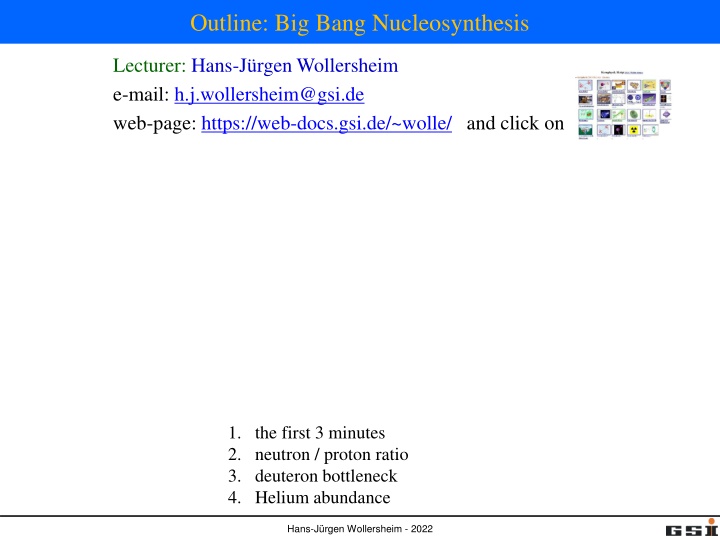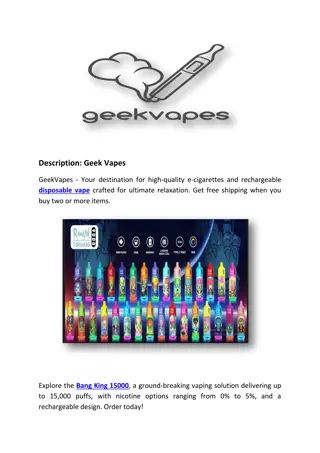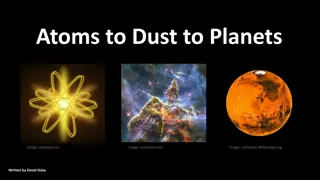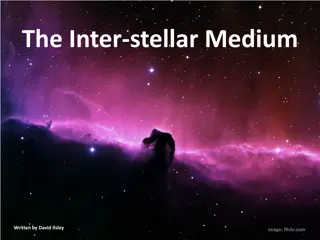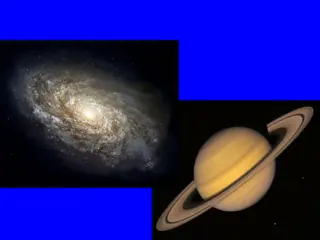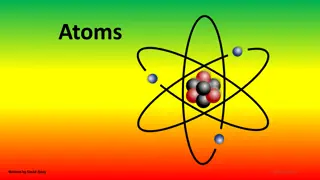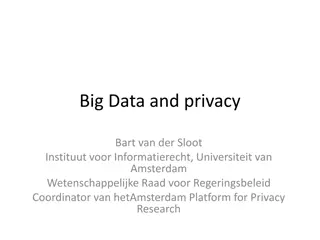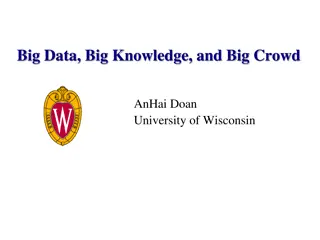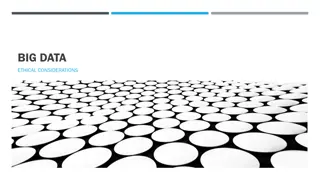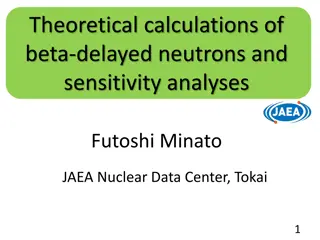Outline: Big Bang Nucleosynthesis
In this overview of Big Bang Nucleosynthesis, learn about the main steps, neutron-to-proton ratio, deuteron bottleneck, helium abundance, and the evolution of the early universe. Explore the aspects of the universe's formation within the first 3 minutes, including the formation of atomic nuclei, the attachment of electrons to nuclei, and the organization of matter into stars and galaxies.
Download Presentation

Please find below an Image/Link to download the presentation.
The content on the website is provided AS IS for your information and personal use only. It may not be sold, licensed, or shared on other websites without obtaining consent from the author.If you encounter any issues during the download, it is possible that the publisher has removed the file from their server.
You are allowed to download the files provided on this website for personal or commercial use, subject to the condition that they are used lawfully. All files are the property of their respective owners.
The content on the website is provided AS IS for your information and personal use only. It may not be sold, licensed, or shared on other websites without obtaining consent from the author.
E N D
Presentation Transcript
Outline: Big Bang Nucleosynthesis Lecturer: Hans-J rgen Wollersheim e-mail: h.j.wollersheim@gsi.de web-page: https://web-docs.gsi.de/~wolle/ and click on 1. the first 3 minutes 2. neutron / proton ratio 3. deuteron bottleneck 4. Helium abundance Hans-J rgen Wollersheim - 2022
The first 3 minutes Steven Weinberg Hans-J rgen Wollersheim - 2022
Big Bang: Main steps 1) Universe started ~15 Ga, the size of an atom, at temperatures (or energy) too hot for normal matter > 1027K it start expanding extremely rapidly 2) Within 10-32seconds, it cools enough to form a quark soup + electrons and other particles 3) At about 1 second, the universe was a hot and dense mixture of free electrons, protons, neutrons, neutrinos and photons. 4) At about 13.8 seconds, temperature has decreased to 3 x 109 K and atomic nuclei began to form, but not beyond H and He. The universe was a rapidly expanding fireball! 5) 700 000 years later electrons became attached to nuclei of H and He formation of true atoms. Matter became organized into stars, galaxies and clusters Hans-J rgen Wollersheim - 2022
The early universe The energy density in the early universe is dominated by radiation. 1 2 ? ? ? 1010? 1? 1 2 ? ?? ? 1??? 1? 1 2 ? ?????= 2.7 ?? ? 3??? 1? Hadron area (t < 10-5s): all matter, including electrons, protons, neutrons, neutrinos and their associated anti-particles are in thermal equilibrium with the photon radiation field. Lepton area (t < 10 s): The temperature decreases such that kT is significantly lower than the rest mass energy of the proton (mp= 938 MeV/c2). The lepton era begins with photons in thermal equilibrium with electrons and positrons, muons, neutrinos and anti- neutrinos. The lepton era ends when the radiation temperature drops significantly below T~5 109K (i.e. kT~ mec2= 511 keV) leaving a small excess of electrons. The radiation temperature/energy as a function of cosmic time Hans-J rgen Wollersheim - 2022
Time ~ 0.01 s At t ~ 0.01 s, the temperature is T ~ 1011K, and kT ~ 10 MeV, which is much larger than the electron mass. Neutrinos, electrons and positrons are easily produced and destroyed by means of weak interactions (i.e., interactions involving neutrinos) ? + ? ?) ? + ?? ??) ? + ?+ ? + ?? ? + ? + ?? ???) ? As long as the weak reactions are fast enough, the neutron-to-proton ratio is given by = ??? ??2 ? ? =?????? ?? ???????? ?????? ?? ???????=??? ??? ?? where m(n) = 939.5 MeV/c2, m(p) = 938.3 MeV/c2, and m = 1.294 MeV/c2. At T = 1011 K, kT = 8.62 MeV yielding n/p = 0.86 This temperature is far above the temperature of nucleosynthesis, but the n/p ratio already begins to drop Hans-J rgen Wollersheim - 2022
Neutron production In thermal equilibrium, the number of neutrons and protons are given by Maxwell- Boltzmann distribution 3 2 ??? ???2 ???? 2? 2 ??= ?? ?? 3 2 ??? ???2 ???? 2? 2 ??= ?? ?? 3 2 ?? ???2 ?? ?? ?? =?? ?? ?? ?? ??? 3 2= 1.002, ?? ???2= ??= 1.29 ??? We can employ a number of simplifications: ??= ??= 2, ???? Therefore, in equilibrium the neutron to proton ratio is ?? ?? = ??? ?? ?? As Qn= 1.29 MeV, this implies a corresponding value of kT ~ 1.5 1010 K. Therefore, at T >> 1.5 1010K we expect nn~ npand at T << 1.5 1010K we expect nn<< np Hans-J rgen Wollersheim - 2022
Neutron / Proton ratio 0.1% mass difference is critical! Hans-J rgen Wollersheim - 2022
Neutron / Proton He / H Deuterium production: ? + ? ? + ? ?? ???? ?? ? ????? ????= 0.75 ?? ???? ?? ?? ?????????? ?????????? ????? ????= 0.25 Hans-J rgen Wollersheim - 2022
Big Bang Nucleosynthesis (BBN) A summary of the BBN when the temperature of the universe allowed deuteron to be formed without being immediately destroyed by photons is: 1. The light elements (deuterium, helium, and lithium) were produced in the first few minutes after the Big Bang. 2. Elements heavier than 4He were produced in the stars and supernovae explosions. 3. Helium and deuterium produced in stars do not to match observation because stars destroy deuterium in their cores. 4. Therefore, all the observed deuterium was produced around three minutes after the big bang, when T ~ 109K 5. A simple calculation based on the n/p ratio shows that BBN predicts that 25% of the matter in the Universe should be helium 6. More detailed BBN calculations predict that about 0.001% should be deuterium Hans-J rgen Wollersheim - 2022
Onset of Big Bang nucleosynthesis (BBN) Deuterium production: ? + ? ? + ? delayed until the high energy tail of blackbody photons can no longer break up D. Binding energy: BD= 2.2 MeV. ???? = ?? 109~20 ????~?? ??~0.1 ??? ?~109 ? ?~200 ? Thermal equilibrium + neutron decay: thus, at most, ????~7 ????= 1 6 Deuterium readily assembles into heavier nuclei Hans-J rgen Wollersheim - 2022
Key fusion reactions Hans-J rgen Wollersheim - 2022
Deuterium bottleneck As the temperature of the universe decreased, neutrons and protons started to interact and fuse to a deuteron ? + ? ? + ? The binding energy of deuterons are small (EB= 2.23 MeV). The baryon-to-photon ratio, called , at this time is also very small (< 10-9). As a consequence, there are many high- energy photons to dissociate the formed deuterons, as soon as they are produced. The temperature for nucleosynthesis at the start is about 100 keV, when we would have expected ~ 2 MeV, the binding energy of deuterium. The reason is the very small value of . The BBN temperature, ~ 100 keV, corresponds to timescales less than about 200 sec. The cross-section and reaction rate for the reaction is ? ?~5 10 20 ??3??? So, in order to achieve appreciable deuteron production rate we need ?~10 17 ?? 3. The density of baryons today is known approximately from the density of visible matter to be ?0~10 7 ?? 3 and since we know that the density scales as ? 3~?3, the temperature today must be ?0= ?0? 1 3????~10 ?, which is a good estimate. Hans-J rgen Wollersheim - 2022
Deuterium bottleneck The bottleneck implies that there would be no significant abundance of deuterons before the universe cooled to about 109K. Other important facts are: 1. The nucleon composition during BBN was proton-rich 2. The most tightly bound light nucleus is 4He 3. There is no stable nucleus with mass numbers A = 5 and A = 8 4. The early universe was too cold and not dense enough to overcome the Coulomb barriers to produce heavier nuclides 5. The BBN network is active until all neutrons are bound in 4He. As the BBN mass fraction of neutrons was Xn= Nn/ (Nn+ Np) = 1/8, it follows that the mass fraction of 4He after BBN is about X4He= 2 Xn= 25% Hans-J rgen Wollersheim - 2022
BBN prediction the Helium abundance BBN predicts that when the universe had T = 109K (1 minute old), protons outnumbered neutrons by 7:1. When 2H and He nuclei formed, most of the neutrons formed He nuclei. That is, one expects 1 He nucleus for every 12 H nuclei, or 75% H and 25% He. This is the fraction of He and 2H we observe today. Hans-J rgen Wollersheim - 2022
Primordial abundances Because 4He is so stable, all fusion pathways lead to 4He, and further fusion is rare. Thus almost all neutrons end up in 4He, and residual protons remain free. (p + p 2He does not occur) To first order, with Np/Nn~ 7 Primordial abundances of H and He (by mass, not number) Hans-J rgen Wollersheim - 2022
The BBN reaction network After deuterons are produced at T ~ 109K, a successive chain of nuclear reactions occur. The most important are Except for 7Be electron capture, all reactions are fast. The binding energies of 3He, 3H, 4He are significantly larger than the one of deuterons. Thus these nuclei are not dissociated again. At T ~ 108K BBN terminates because the temperature and density are too low the Coulomb barriers are too high Hans-J rgen Wollersheim - 2022
BBN nuclei in stars Deuteron In stellar processes deuteron is quickly converted to 3He. Astronomers look at quasar: bright atomic nuclei of active galaxies, ten billion light years away 3He star account for only 0.1% of all He. The 3He abundance in stars is difficult to deduce. Its abundance is increasing in stellar fusion. Scientists look to our own galaxy. 7Li 7Li can form when cosmic rays collide with stellar gas. Observations can be made on old, cool stars in our own galaxy. 7Li is destroyed more that it is created inside stars. Very old stars have low oxygen content, and their outermost layers still contain mostly primordial 7Li Hans-J rgen Wollersheim - 2022
Time evolution of BBN mass fractions thermal equilibrium reactions freeze out due to expansion ?? ???2 ?? ?? ?? ??? ? ? 1 ? 1 2 Mass fractions of light nuclei as a function of time during the BBN Hans-J rgen Wollersheim - 2022
Primordial abundances Note: Light elements have been made and destroyed since the Big Bang Some are made in stars: stars (3He, 4He) spallation (scattering) (6,7Li, Be, B) supernova explosions (7Li, 11B) Some are destroyed d, Li, Be, B are very fragile they are destroyed in the center of stars observed abundances (at surface of stars) do not reflect the destruction side Hans-J rgen Wollersheim - 2022
